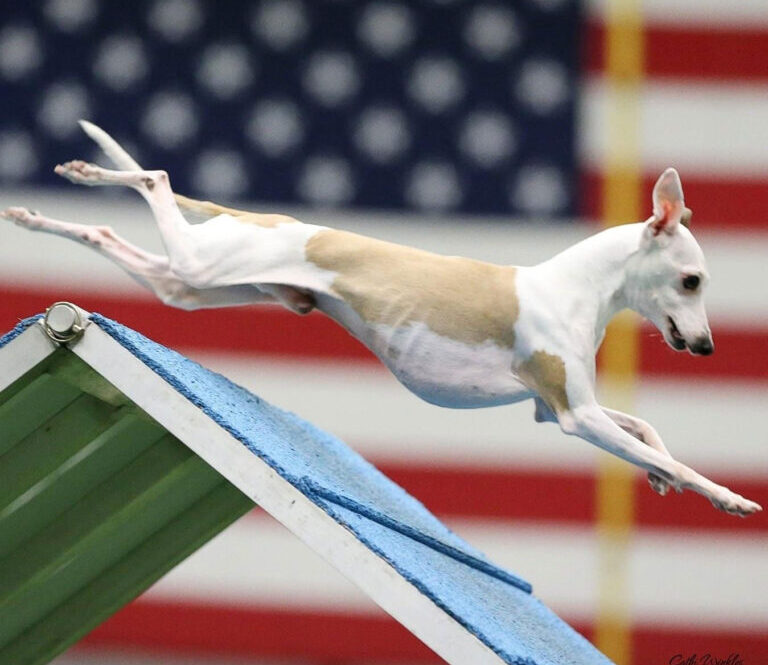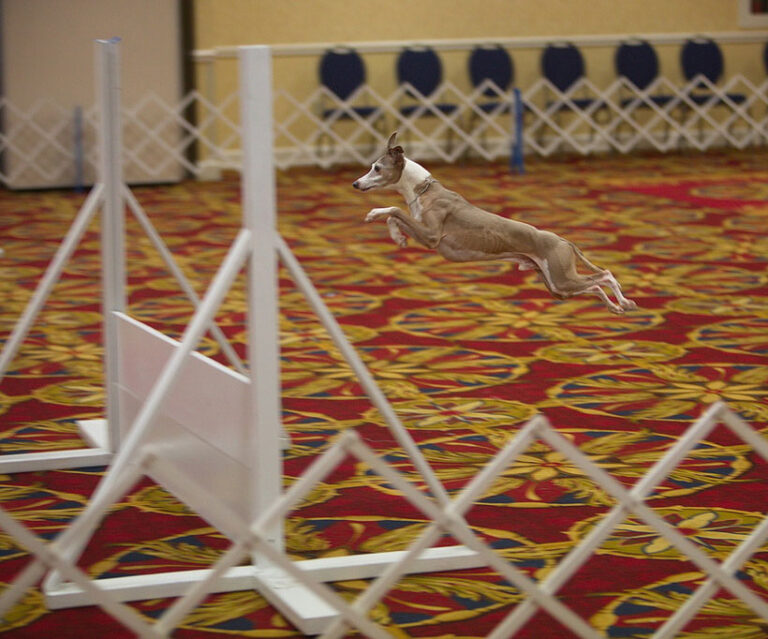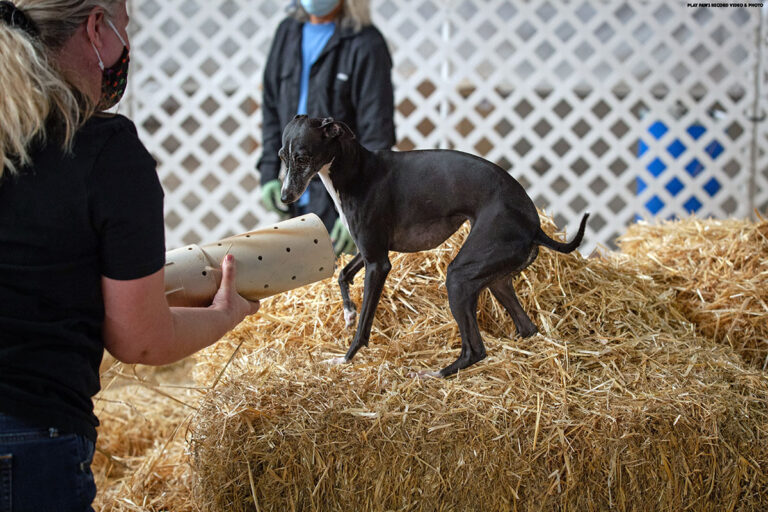Performance & Sports
Agility
Agility is right up the Italian Greyhound’s alley because it combines speed, agility and fun! Agility is like obedience in that exhibitors can make it as competitive as they wish. Some people get hooked to the sport by just “having fun” with their dogs at a class and surprising themselves by picking up a qualifying leg at their first trial. There are several AKC agility titles available. For more info on AKC Agility go to the AKC Agility Page.

Another benefit to this sport is that the handlers tend to get into shape also. They must direct their dogs to the different obstacles. For IG owners, this means fast thinking because outrunning their dog would be very difficult. Have fun! Learn More about Agility
Lure Coursing
One of the most natural and exciting sports that Italian Greyhounds can compete in is lure coursing. Lure coursing competition attempts to create a simulation of a hare’s flight to evade a pursing hound. The hare’s path is generated by a continuous line looped through a series of pulleys producing a set of straightaways and varying turns. Please don’t be alarmed, instead of a live bunny, a set of white plastic bags are attached to the line to attract the IG’s attention. At a competition, IGs run in trios with traditional greyhound style racing blankets. Judging is not according to time but rather ability to follow the lure, enthusiasm, agility, speed and endurance. Before you start lure coursing, make sure that your Italian Greyhound is in good physical condition. The IG should be getting frequent, vigorous exercise and its feet should be conditioned to a variety of surfaces. We strongly recommended that your IG be run at several practice events, alone, before entering a trial so you may gauge its fitness, reactions to other hounds on the field, and interest in coursing the lure.
An Italian Greyhound may compete in American Kennel Club (AKC) lure coursing or American Sighthound Field Association (ASFA) trials. AKC rules and a list of AKC approved lure coursing clubs is available from the AKC web site, as is a searchable schedule of events. The American Sighthound Field Association (ASFA) is a national organization dedicated to preserving the function and natural beauty of sighthounds. Learn More About Lure Coursing on AKC.org
CAT Tests
One of the easiest ways to get involved in the world of dog sports is with a Coursing Ability Test (CAT). Each dog chases after an artificial lure on either a 300- or 600-yard long course and must finish in less 1 ½ minutes and 2 minutes, respectively. Dogs are run individually, and scored pass/fail. Learn More About CAT Tests on AKC.orgFast CAT
Think of Fast CAT® – which stands for Coursing Ability Test – like measuring a track star’s speed: Dogs run individually in a timed 100-yard dash. Learn More About FAST CAT on AKC.orgRacing
The Large Gazehound Racing Association, (LGRA) recognizes IGs as well as many other non‐whippet sighthound breeds. IGs are eligible to compete for the GRC (Gazehound Racing Champion) title and Supreme GRC title. LGRA racing is 200 yard straight track sprint racing. In addition, National Oval Track Racing Assoc (NOTRA) also recognizes IGs. IGs are eligible to compete for Junior Oval Racer (JOR), Senior Oval Racer (SOR), Oval Racing Champion (ORC) and Supreme ORC titles. NOTRA holds 300‐400 yard races on an oval track.
Please note that all IG racing is amateur racing only. Dogs compete only for titles and ribbons, not for money. Mostly though, they compete because they love to run and chase! In LGRA and NOTRA race meets the dogs chase an artificial lure pulled by a small motor.
Contact the club nearest you for assistance with information on practices, blanket information, muzzles etc. Remember that all these clubs are run by volunteers, most of whom have very busy dog lives of their own. Be patient if it takes a few tries to reach one of them. When you show up at a race meet, be prepared to learn, and be prepared to start pitching in and helping with setup etc. Start learning the procedures, and before you know it, you’ll be asked to “line judge” races that your dogs are not running in.
Obedience
Obedience trials test an Italian Greyhound’s ability to perform a set of exercises. In each exercise, a dog/handler team must score more than 50% of the possible points and accumulate a total score (for all of the exercises) of at least 170 out of a possible 200. Each time your dog scores the 170 qualifying score, he has gotten a “leg” toward his title. After three legs, your dog has become an obedience titled Italian Greyhound.
There are three levels at which your dog can earn a title with the levels increasing in difficulty. The three levels of competition are Novice, Open and Utility. The first level, Novice, results in your dog earning a Companion Dog (CD) title. Your dog will have to heel both on and off leash at different speeds, come when called, and stay still for a simple physical examination and with a group of other dogs. The second level, Open, results in your dog earning a Companion Dog Excellent (CDX) title. At this level, the leash is off and jumping and retrieving exercises are added. The final level, Utility, results in your dog earning a Utility Dog (UD) title. The exercises at this level are the most difficult and require a “thinking” dog. In addition to the jumping exercises, the dog must now also perform scent discrimination tasks.

If you would like more information on obedience training, information about the obedience rules, and to locate training clubs in your area, contact the American Kennel Club (AKC). Learn More About Obedience on AKC.org
Rally
Think of an AKC Rally event as any team sport: You and your dog navigate a course, side-by-side, as you steer him through a course of 10-20 different signs. Each of these signs provides instructions regarding the next skill that is to be performed. The dog and handler move continuously throughout the course with the dog under control at the handler’s left side. There is a clear sense of teamwork between the dog and handler both during and between the numbered signs. Although each performance is timed, having a good race time is not the goal; it’s all about working as a team while performing the skills, with the dog under control. Learn More about Rally on AKC.orgScent Work
The sport of Scent Work is based on the work of professional detection dogs (such as drug dogs), employed by humans to detect a wide variety of scents and substances. In AKC Scent Work, dogs search for cotton swabs saturated with the essential oils of Birch, Anise, Clove, and Cypress. The cotton swabs are hidden out of sight in a pre-determined search area, and the dog has to find them. Teamwork is necessary: when the dog finds the scent, he has to communicate the find to the handler, who calls it out to the judge. Learn More about Scentwork on AKC.org
Barn Hunt
Not everyone will understand the importance of “rat catchers,” but if you live in the countryside, you sure do! “Rat catchers” rid farms of destructive vermin – and the hunting and teamwork skills required to do so are the foundation of the sport of Barn Hunt. Dogs and their handlers work as a team to locate and mark rats (which are always safely held in aerated tubes) hidden in a maze of straw or hay bales. Some breeds are specifically created to fill this role as well as some mixed breeds being up to the task, but as long as your dog can fit through an 18″ wide by bale-height tall tunnel, he’s eligible! “Barn Hunt tests the nose, speed, agility, and surefootedness of dogs that have a history of above-ground vermin hunting,” said Robin Nuttall, founder of the Barn Hunt Association.” Learn More about Barn Hunt on barnhunt.com

